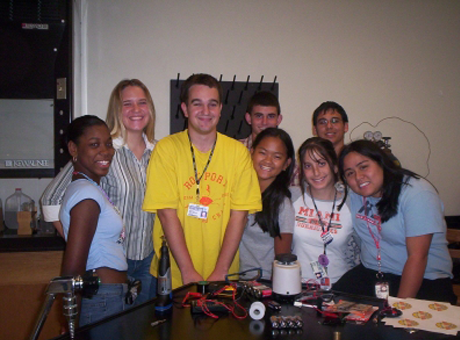Dr. Michael M. Krop Senior High School InvenTeam
Miami, Florida
Alkaline batteries discharge quickly and need to be replaced often. Even rechargeable batteries are expensive and need to be charged frequently. The Dr. Michael Krop Senior High School InvenTeam wanted to create an alternative source of energy that would either replace or increase the power and efficiency of batteries. The team created a kinetic fuel cell as a new source of energy. They created several prototypes for different applications, such as using the fuel cell to recharge and strengthen a battery or using it with a capacitor as an alternative power source for electronic devices. The kinetic fuel cell uses the kinetic energy of motion to charge itself. It takes advantage of both kinetic and magnetic fields that are gained and lost due to the continuation and cessation of motion. The first prototype application was constructed inside the shell of a ballpoint pen. It consisted of one stationary and one repelling magnet. After adapting some of the principles of Faraday's Law, the team used levitating magnets to create the cell. The use of both the positive and negative poles of a stationary and levitating magnet made it possible to create DC voltage through a simple magnetic levitation system. Positive voltage is trapped around the moving magnet and negative voltage is trapped between the moving and stationary magnets. Two separate copper coils pull energy out of these two fields, and the voltage is read on a separate volt-meter. The team discovered the device could create approximately 1.83 volts. This kinetic cell can be used as a power source with capacitors, or attached to the negative and positive ends of a battery to strengthen its power output and keep it charging. The team started the design process by examining the theoretical science necessary for the kinetic fuel cell to function. They used standard batteries in their tests until their team advisor recommended Neodymium, the strongest commercially available magnet. The team created many different prototypes to test the kinetic cell. The team's first prototype, which evolved from the integration of the device in the ballpoint pen, was a cell phone battery charger. They also created "D" and "AA" sized kinetic cells that used a kinetic generator along with a rechargeable button cell battery in order to generate an electrical charge by kinetic motion. These sizes made the kinetic cell convenient to use. Other creations were the "Kinetic System" which used a 2000 percent kinetic cell to generate and store DC voltage and a kinetic skateboard that turned energy lost to the ground into electricity. The team met every week to work on their invention. Tony Wedderburn, CEO of AccuTech provided advice on the potential commercialization of the team's project. The Michael Krop Senior High School InvenTeam was pleased with the invention, but recognized that there is room for improvement. The students want to make the kinetic cell transferable between electronic devices, and they hope to market and manufacture it. They have also decided to further explore the use of the kinetic cell in prosthetics, military applications, consumer devices, and hybrid vehicles.


